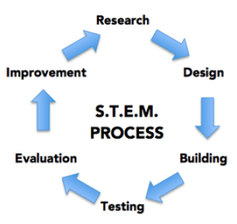
Today that has changed. Information is readily available, and business wants to hire people who can think and solve problems. As teachers we have long understood that it is not enough to simply present content. We have to create students capable of high-level thinking.
This can be supported both by experience and by research. We all remember studying Bloom’s Taxonomy in our teacher prep courses. Beginning with the lowest level: remembering facts, the spectrum moves upward through comprehension, application, analysis, synthesis, and evaluation. This has been revised in our era somewhat and now moves from remembering, to understanding, applying, analyzing, evaluating, and creating. The important consideration in either case is that simple recall of facts demands the least of students. As we saw at the beginning of this article, this once was enough, but today it is not.
A project-based approach as we see in S.T.E.M. lessons allows students to move seamlessly up through this progression. When students are asked to engineer a solution to a problem, they must not only possess the content knowledge to tackle the task, they must understand and comprehend that content to know how to apply it to the situation. They must be able to analyze and evaluate the results of their attempt. The problem demands that they synthesize their knowledge and create a solution.
I have presented this process to my students as a cyclical approach. They begin with research in which they gather content knowledge about the problem and explore known solutions. Then they design their solution, build it, and test it. After testing, they evaluate the result and work to improve it so they can restart the process.
That S.T.E.M. instruction fosters higher-order thinking can also be supported through experience. Teachers who incorporate project-based learning have seen the creativity and resourcefulness – not to mention the excitement and engagement – of their students blossom as they tackle challenging problems. In our attempts to teach high-order thinking, S.T.E.M. is one of our most effective tools.
 RSS Feed
RSS Feed